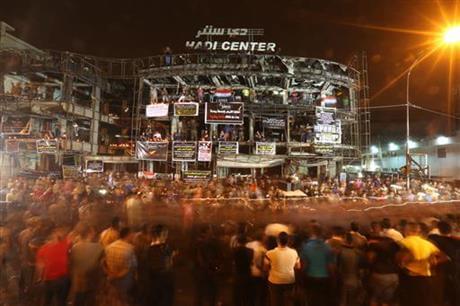
By HAMZA HENDAWI and SINAN SALAHEDDIN
Dozens of men were watching a soccer match at the “Smile” cafe when the blast hit in the street below. Within minutes, a fire ripped through the Baghdad shopping mall where they were gathered, trapping them in a crowd on the second floor.
There were no fire exits, no firefighters. An iron gate to the roof was padlocked.
One of those watching the match, Majid Toamah, kicked a hole in an aluminum wall in the cafe and leaped 20 meters (yards) to the alley below. The 40-year-old broke both his legs. As he lay in agony, he looked up to see terrified faces staring out of the hole.
“They were too scared to jump. The face of one of them caught fire,” Toamah remembered. “In the end, they all died.”
Sponsored Links
43 Lost World War 2 Photos They Couldn’t Show Until Now
Daily Bananas
20 Things Bewitched Producers Hid From Fans
Trend Chaser
At least 292 people died from the July 3 car bombing in Baghdad’s central Karradah district. Most of the deaths resulted not from the blast itself, but from the ensuing inferno, fed by a tinderbox of shops in two malls filled with clothing and oil-based perfumes for sale and lined with flammable panels. It was all worsened by a slow response by firefighters, building code violations — and a lack of water.
As a result, two three-story shopping malls separated by a broad avenue and several other buildings were rendered charred skeletons. It was the deadliest attack by a single bomber since Iraq’s war began in 2003, and the toll is likely to rise further as authorities struggle to identify more human remains.
“We are still sifting through the debris,” Civil Defense member Mustafa Khudair Hamad said days after the fire “and remains are still coming out.”
Hassan Abdul-Zahra, who worked at a women’s clothing store near the blast site, recalled listening to desperate screams for help from people trapped in the malls. “I could even hear the angel of death reaping lives,” he said.
Public grief has been stoked by anger over deeply rooted corruption and inefficiency that may have cost lives. State Civil Defense Forces, under heavy criticism, blamed the absence of safety standards.
“The culture of safety measures is almost zero in Iraq,” Brig. Gen. Kadhim Bashir Saleh of the Civil Defense force told The Associated Press. “Some investors do not care about applying safety standards in their projects to keep the costs low and even store owners do not consider buying fire extinguishers.”
He said the two malls, the Hadi and Laith centers, lacked emergency exits and stairs, sprinklers and fire hoses and had “unprofessional wiring.” He said authorities had previously issued a warning to the owners of the two malls and, after getting no response, had filed a court case against them.
It took 30 minutes for the first two fire engines to reach the blaze, and they soon ran out of water, according to accounts by several witnesses, including AP photographer Hadi Mizban. It took the next wave of fire engines and army water tanks an hour to make their way to the fire through burnt cars and concrete security barriers on side roads normally closed to traffic.
During that time, the fire spread from the Hadi Center, where the bomber struck, to the Laith Center and nearby buildings. Mizban said he saw two people fleeing the Laith Center in flames before they collapsed on the sidewalk and died. Those trapped frantically called relatives, telling them their location inside the two malls and pleading for rescue.
Jalal al-Aaraji was one of several Karradah residents who risked their lives to rush into the burning malls in hopes of helping survivors. He was unable to save anyone.
As the fire raged, he climbed up air conditioner units on the side of the Laith Center and broke open a second-floor wall with a sledgehammer. Inside, he could hear the cries from small storage rooms where people had locked themselves in for refuge. But as he tried to find a way around the flames to reach them, the cries stopped, he said.
He spent the next hours retrieving bodies, with families of the missing calling out directions to him from below.
“Often I found their relatives where they said they were. Dead,” he said.
The majority of victims appear to have been in the Hadi Center, where people had been shopping for the Muslim holiday of Eid al-Fitr. The flames quickly swept through packed stores, a pizza restaurant and a billiard hall packed with people, and up to the Smile cafe, where soccer fans were watching the Euro 2016 quarterfinal match between Germany and Italy and another group was having a birthday party.
If the buildings had proper safety standards, the death toll would have been exponentially lower, said a Baghdad-based engineer, Mohammed Hadi Hussein.
“In today’s Iraq nothing can stop violations, thanks to corruption,” said Hussein, who owns the Land of Engineering and Planning company. “The law is there and clear, but corruption is also there.”
He could not speak of the two malls. But he said often construction companies submit maps to authorities that have been drawn to standards, but then change them in the actual building to cut costs.
In a sign of how deeply felt the horror is over the Karradah blast, the site has been turned into a makeshift shrine, a rare memorial in a city of 7 million that has seen countless bombings over the years. Death notices cover the burned-out structures, many bearing photos of the victims.
Women, quietly sobbing or crying uncontrollably, place candles or flowers where they believe their loved ones fell. Some silently read from copies of the Quran. Men pound their chests with their hands in a customary Shiite gesture of mourning.
Discuss this story on Twitter or Facebook



